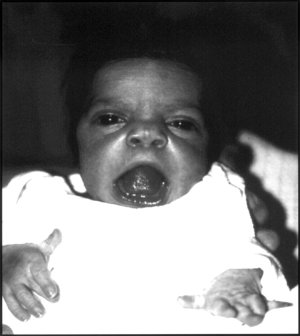Robinow Syndrome

Robinow syndrome (RS) is a rare genetic syndrome characterized by limb shortening and abnormalities of the head, face and external genitalia.
Epidemiology
Exact prevalence is unknown. About 200 cases have been reported to date. Cases have been reported primarily from the USA, Arab countries, Turkey, Czech Republic and Slovakia, the Indian subcontinent, and Brazil. Prevalence in other geographic areas is unknown. There is an equal male-to-female ratio.
Clinical description
Two forms of the syndrome with different patterns of inheritance and variable frequency of clinical signs have been described: a milder autosomal dominant form (autosomal dominant Robinow syndrome, see this term) and a more severe autosomal recessive form (autosomal recessive Robinow syndrome, see this term). The syndrome has a wide clinical spectrum. Clinical signs such as short stature, characteristic facial features (hypertelorism, midface hypoplasia, large nasal bridge, short upturned nose, and anteverted nares), mesomelic limb shortening, as well as brachydactyly, clinodactyly, gingival hyperplasia, and genital hypoplasia are generally common to both forms. Vertebral segmentation defects are common but more severe in the recessive form: hemivertebrae and scoliosis are more common (75% of cases). Rib fusions appear to be present almost exclusively in the autosomal recessive form. Umbilical hernia and supernumerary teeth appear to be present exclusively in patients with the dominant form. Associated conditions include frequent ear infections, hearing loss, developmental and respiratory disorders, hypotonia, eating difficulties and esophageal reflux.
Etiology
Autosomal recessive Robinow syndrome is caused by mutations in the ROR2 gene (9q22). Mutations in the WNT5A gene (3p14.3) have been reported in some patients (< 10%) with autosomal dominant Robinow syndrome.
Diagnostic methods
Diagnosis is based on the clinical picture and the characteristic fetal face appearance of patients. Radiological examination is however necessary to confirm the presence of skeletal malformations.
Differential diagnosis
The main differential diagnosis is RS with a different pattern of inheritance. Syndromes that commonly involve dysmorphic facial features similar to RS, particularly hypertelorism, along with genital hypoplasia such as Aarskog-Scott syndrome and Opitz G syndrome (see these terms) should also be considered. Chromosome abnormalities have occasionally been reported in patients with a Robinow-like phenotype. Similar costovertebral segmentation defects can be found in autosomal recessive spondylocostal dysostosis (ARSD) (see this term).
Antenatal diagnosis
Prenatal diagnosis may be performed by fetal ultrasound from the 19th week of pregnancy but the severity of the syndrome is difficult to ascertain. Genetic testing may be performed to confirm the diagnosis in AR cases.
Genetic counseling
Transmission is autosomal dominant or recessive. Genetic counseling is recommended. Parents of AD cases should be clinically evaluated to exclude a milder manifestation of the syndrome prior to genetic counseling.
Management and treatment
Management of the skeletal deformities includes bracing or surgical correction. Growth hormone has been administered to increase the growth rate in children with the syndrome. In patients with wide palpebral fissures, the need for surgical intervention should be evaluated.
Prognosis
Prognosis of Robinow syndrome is generally good but the severity of heart disorders may affect life expectancy.